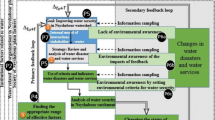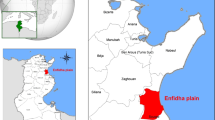Abstract
This article explores the potentials of systems analysis and design of information system for sustainable natural resource management. Soft and hard system analyses were performed to better understand the information needs and design of an information system for improving decision making for achieving sustainable natural resource management. In order to analyze the complex and soft systems situations for developing an effective information system, which meets related actors’ changing needs, a conceptual model inspired by soft systems methodology (SSM) was developed. This model is based on information derived from twelve farmers who were purposely selected to represent diverse conditions and 23 agricultural extension experts across the Alborz Watershed in Mazandaran Province, located in northern Iran. Since a conceptual model resulting from SSM is not in itself sufficient as the basis for the implementation of information systems, a hard system methodology was used to structure the data handling by using unified modeling language. This research has shown the promising potentiality of using soft system analysis methodology as a preliminary step to the actual design of an information system in the natural resource management situation in the watershed system level when combined with hard system analysis methods.









Similar content being viewed by others
References
Anderson J (2007) Agricultural advisory services. A background paper for WDR 2008. World Bank, Washington DC
GRID Arendal (2001) The extent of areas of degraded land in the world and the location of degraded soil. http://www.grida.no/publications/other/geo3/?src=/geo/geo3/english/fig65.htm
Babu RA, Singh YP, Sachdeva RK (1997) Managing human resources within extension. In: Swanson BE, Bentz RP, Sofranko AJ (eds) Improving agricultural extension: a reference manual. Food and Agriculture Organization of the United Nations, Rome, pp 180–202
Badripour H (2004) Country pasture profiles, Iran. Food and Agriculture Organization of the United Nations, Rome
Bosch OJH, King CA, Herbohn JL, Russell IW, Smith CS (2007) Getting the big picture in natural resource management: systems thinking as ‘Method’ for scientists, policy makers and other stakeholders. Syst Res Behav Sci 24(217):232
Carberry PS, Hochman Z, McCown RL, Dalgliesh NP, Foale MA, Poulton PL, Hargreaves JNG, Hargreaves DMG, Cawthray S, Hillcoat N, Robertson MJ (2002) The FARMSCAPE approach to decision support: farmers’, advisers’, researchers’ monitoring, simulation, communication and performance evaluation. Agric Syst 74:141–177
Checkland P (1981) Systems thinking, systems practice. The development of a prototype. Wiley, Chichester, p 416
Checkland PB (1988) Information-systems and systems thinking—time to unite. Int J Inf Manage 8(4):239–248
Checkland P (1999) Soft systems methodology in action. Wiley, Chichester, p 418
Checkland P, Scholes J (1990) Soft systems methodology in action. Wiley, Chichester
Checkland P, Scholes J (1999) Soft systems methodology in action. Wiley, Chichester
Darvishsefat A, Abbasi M, Mohajer MRM (2003) Evaluation of the potential of landsat ETM for forest type mapping in northern Iran. International archives of photogrammetry remote sensing and spatial information sciences, vol 34. Part 7/B, pp 956–957
FAO (2006a) Food security statistics. Food and Agriculture Organization of the United Nations, Rome. http://www.fao.org/es/ess/faostat/foodsecurity/index_en.htm
FAO (2006b) Global Forest Resources Assessment 2005: progress towards sustainable forest management. FAO Forestry Paper 147. Forestry Department, Food and Agriculture Organization of the United Nations, Rome
Foltz RC (2002) Iran’s water crisis: cultural, political, and ethical dimensions. J Agric Environ Ethics 15(4):357–380
Forest and Range Organization of Iran (2001) The long term plan of Forest and Range Organisation of Iran for evolving renewable natural resources. Forest and Range Organization of Iran (Persian), Tehran
Forest Range and Watershed Management Organization of Iran (2005) Iran’s natural resources: yesterday, today and tomorrow. Livestock and Agri-bussiness Mahnameh, Tehran
Fountas S, Kyhn M, Lipczak Jakobsen H, Blackmore S, Griepentrog HW (2009) Systems analysis and information management of a university research farm. Precis Agric 10(3):247–261
Hansen JP (2005) Supporting local advisory services by dissemination of information over the internet. In Nowoczesne techniki informacyjne w nauce, edukacji i doradztwie dla wsi i rolnictwa, Materialy konferencji, edited by Dział Os´wiaty i Wspo´łpracy Naukowej Kcdrriow (pp. 1–59). Warzawa, Poland: Centralna Biblioteka Rolnicza. Bolivia and Mali. J Rural Stud 23:23–37
Hjortsø CN, Christensen SM, Helles F (2005) Using soft systems methodology to develop a mangrove forest management and planning decision support system in a buffer zone. The Case of Dam Doi Forest Enterprise, Vietnam. Forest & Landscape Working Papers no. 10-2005. www.SL.kvl.dk
Huang Hu, Escobar C, Wiesmann U, Zimmermann A (2005) Moving from sustainable management to sustainable governance of natural resources: the role of social learning processes in rural India, Bolivia and Mali. J Rural Stud 23(2005):23–37
Iranian Ministry of Agriculture (2004) Alborz integrated land and water management project. http://www.ailwmp.ir/en/home_en.htm
Jensen AL (2001) Building a web-based information system for variety selection in field crops— objectives and results. Comput Electron Agric 32:195–211. doi:10.1016/S0168-1699(01)00165-X
Karami E, Hayati D (2005) Rural poverty and sustainability: the case of groundwater depletion in Iran. Asian J Water Environ Pollut 2(2):51–61
Karamidehkordi E (2010) A country report: challenges facing Iranian Agriculture and Natural Resource Management in the twenty-first century. Hum Ecol 38:295–303
King CA (1998) A process-analysis approach for improving multi-disciplinary farming systems research, development and extension. In: Proceedings of the third European symposium on rural and farming systems analysis: environmental perspectives, Germany
Leeuwis C, Van den Ban A (2004) Communication for rural innovation. Rethinking agricultural extension. Blackwell Science/CTA, Oxford/Wageningen
Likens GE (2010) The role of science in decision making: does evidence-based science drive environmental policy? Front Ecol Environ 8(6):e1–e9. doi:10.1890/090132
Likens GE, Walker KF, Davies PE et al (2009) Ecosystem science: towards a new paradigm for managing Australia’s inland aquatic ecosystems. Mar Freshw Res 60:271–279
Macadam R, Britton I, Russell D, Potts W, Baillie B, Shaw A (1990) The use of soft systems methodology to improve the adoption by Australian cotton growers of the siratac computer-based crop management system. Agric Syst 34:1–14
McCown RL (2002) Changing systems for supporting farmers decisions: problems, paradigms and prospects. Agric Syst 74:179–220
Nader MR, Karam N (2008) Present status of agricultural information technology systems and services in Bangladesh. http//jsai.orj.jp/afita/afita-conf/2008/part1/p075.pdf
Nash E, Bill R, Bobert J (2007) Anwendungsfallanalyse für den einsatz von GDI Technologien in precision farming [Use-case analysis for the application of SDI-technologies in precision farming]. GIS-Zeitschrift für Geoinformatik 11:14–21
Rekacewicz P (2006) Excessive withdrawal of renewable water resources. http://www.grida.no/graphicslib/detail/excessive-withdrawal-of-renewable-water-resources_f365
Rekacewicz P and UNEP/GRID-Arendal (2007) Drought in central and southwest Asia. http://www.grida.no/graphicslib/detail/drought-in-central-and-southwest-asia_12b9
Rammel C, Stagl S, Wilfing H (2007) Managing complex adaptive systems—a co-evolutionary perspective on natural resource management. Ecol Econ 63:9–21
Reid JI, Gray DI, Kelly TC, Kemp EA (1999) An application of SSM in the onfarm labour situation in the New Zealand dairy industry. Syst Res Behav Sci 16:250–341
Rezaei-Moghadam K, Karami E (2008) Developing a green agricultural extension theory. Int J Sustain Dev Planing 3(3):242–256
Roling N (1988) Extension science. Information systems in agricultural development. Cambridge University Press, Cambridge
Sabetraftar A, Abbaspour M (2003) Study and analysis of drought environmental impacts with emphasis on role of water management to mitigate consequences of drought in Iran. Internation Workshop on Drought Management Strategies, Iranian National Committee on Irrigation and Drainage (IRNCID), Tehran. http://www.irncid.org
Sørensen CG, Fountas S, Nash E, Pesonen L, Bochtis D, Pedersen SM, Basso B, Blackmore SB (2010) Conceptual model of a future farm management information system. Comput Electron Agric 72(1):37–47
Swanson BE (2008) Global review of good agricultural. Extension and Advisory Service Practices. FAO, Rome
The Canadian Trade Commissioner Service (2000) World development report 2000: agricultural for development, overview. The Canadian Trade Commissioner Service, Canada
UNEP (1992) the extent of areas of degraded land in the world and the location of degraded soil (map). http://www.grida.no/publications/other/geo3/?src=/geo/geo3/english/fig65.htm
UNEP (2006) Annual Report: summary of UNEP’s activities in 2006. Year of Publication: 2007. UNEP. ISBN No: 978-92-807-2801-9
Van den Ban AW, Samanta RK (eds) (2006) Changing roles of agricultural extension in Asian Nations. B.R. Publishing, Delhi
Venters W, Cornford T, Cushman M (2005) Knowledge about sustainability: SSM as a method for conceptualizing the UK Construction industry’s knowledge environment. J Comput Inf Technol 13(2):137–148
Vernon R (2001) Knowing where you are going: information systems for Agricultural Research Management. International Service for National Agricultural Research, The Hague
Walker DH (2002) Decision support, learning and rural resource management. Agric Syst 73:113–127
Walker DH, Cowell SG, Johnson AKL (2001) Integrating research results into decision making about natural resource management at a catchment scale. Agric Syst 69:85–98
Watershed Management Deputy (2003) Strategic model of participatory integrated watershed management in Iran. In: Third seminar of Aquifer Management, Achievement and Perspective Tehran, Soil Conservation and Watershed Management Research Centre, 15–16 December 2003
Acknowledgments
This article is based in part on the research carried out with financial support from the Department of Agricultural Extension & Education, University of Tehran, Iran, which is gratefully acknowledged. The authors express appreciation to Dr. S.Y.Hedjazi and Dr. A.Asadi for their consultation, and Dr. A. Alambeigi for his assistance in this research. Finally, the authors would like to thank the Farmers and Agricultural Extension Experts who participated in the interviews.
Author information
Authors and Affiliations
Corresponding author
Rights and permissions
About this article
Cite this article
Hosseini, S.M., Rezaei, A. Developing an Information System for Sustainable Natural Resource Management in Alborz Watershed, Northern Iran. Syst Pract Action Res 26, 131–152 (2013). https://doi.org/10.1007/s11213-012-9240-1
Published:
Issue Date:
DOI: https://doi.org/10.1007/s11213-012-9240-1




